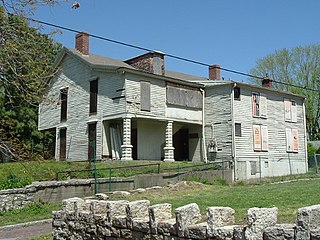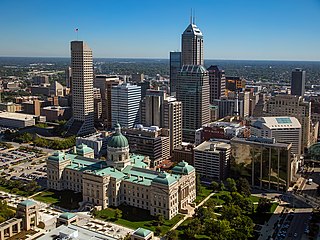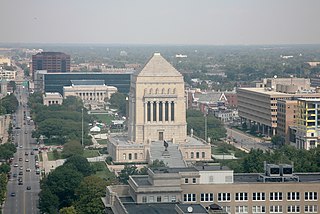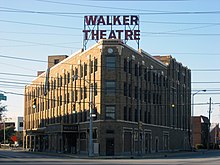
Portland is a historic district, neighborhood and former independent town northwest of downtown Louisville, Kentucky. It is situated along a bend of the Ohio River just below the Falls of the Ohio National Wildlife Conservation Area, where the river curves to the north and then to the south, thus placing Portland at the northern tip of urban Louisville. In its early days it was the largest of the six major settlements at the falls, the others being Shippingport and Louisville in Kentucky and New Albany, Clarksville, and Jeffersonville on the Indiana side. Its modern boundaries are the Ohio River along the northwest, north, and northeast, 10th Street at the far east, Market Street on the south, and the Shawnee Golf Course at the far west.

The William H. Block Company was a department store chain in Indianapolis and other cities in Indiana. It was founded in 1874 by Herman Wilhelm Bloch, an immigrant from Austria-Hungary who had Americanized his name to William H. Block. The main store was located at 9 East Washington Street in Indianapolis in 1896. The company also identified itself as The Wm. H. Block Co., and Block's.
The City of Oklahoma City uses Special Zoning Districts as a tool to maintain the character of many neighborhood communities.

The Wholesale District is one of seven designated cultural districts in Indianapolis, Indiana, United States. Located in the south-central quadrant of downtown Indianapolis' Mile Square, the district contains the greatest concentration of 19th-century commercial buildings in the city, including Indianapolis Union Station and the Majestic Building. Contemporary landmarks in the district include Circle Centre Mall and the Indianapolis Artsgarden.

Indiana Avenue is a historic area in downtown and is one of seven designated cultural districts in Indianapolis, Indiana. Indiana Avenue was, during its glory days, an African American cultural center of the area. The Indiana Avenue Historic District within the area was designated a United States national historic district in 1987.

Downtown Indianapolis is a neighborhood area and the central business district of Indianapolis, Indiana, United States. Downtown is bordered by Interstate 65, Interstate 70, and the White River, and is situated near the geographic center of Marion County. Downtown has grown from the original 1821 town plat—often referred to as the Mile Square—to encompass a broader geographic area of central Indianapolis, containing several smaller historic neighborhoods.

The Madam C. J. Walker Building, which houses the Madam Walker Legacy Center, was built in 1927 in the city of Indianapolis, in the U.S. state of Indiana, and as Madam C. J. Walker Manufacturing Company, it was designated a National Historic Landmark in 1991. The four-story, multi-purpose Walker Building was named in honor of Madam C. J. Walker, the African American hair care and beauty products entrepreneur who founded the Madam C. J. Walker Manufacturing Company, and designed by the Indianapolis architectural firm of Rubush & Hunter. The building served as the world headquarters for Walker's company, as well as entertainment, business, and commercial hub along Indiana Avenue for the city's African American community from the 1920s to the 1950s. The historic gathering place and venue for community events and arts and cultural programs were saved from demolition in the 1970s. The restored building, which includes African, Egyptian, and Moorish designs, is one of the few remaining African-Art Deco buildings in the United States. The Walker Building was added to the National Register of Historic Places in 1980.

Fountain Square is one of seven designated cultural districts in Indianapolis, Indiana. Located just outside the city's downtown district, Fountain Square is home to three designated national historic districts, the Laurel and Prospect, the State and Prospect, and the Virginia Avenue districts, all of which were listed on the National Register of Historic Places in 1983. The neighborhood derives its name from the successive fountains that have been prominently featured at the intersection of Virginia Avenue, East Prospect Street, and Shelby Street.

The Mass Ave Cultural Arts District, colloquially known as Mass Ave, is one of seven designated cultural districts in Indianapolis, Indiana, United States. The district centers on 0.86 miles (1.38 km) of its namesake Massachusetts Avenue, from its southern terminus at New York and Delaware streets to its northern terminus at Bellefontaine Street. The avenue is one of the four original diagonal streets included in Alexander Ralston's plan of 1821. Mass Ave also contains the Massachusetts Avenue Commercial District, a historic district included on the National Register of Historic Places since 1982.
The Bates–Hendricks neighborhood is situated just south and east of the downtown commercial district of Indianapolis, Indiana. The Fountain Square business district is just to the east.

Broad Ripple Village is one of seven areas designated as cultural districts in Indianapolis, Indiana. Located in Washington Township, Marion County, Indiana, about six miles north of downtown Indianapolis, Broad Ripple was first platted in 1837, became incorporated as the Town of Broad Ripple in 1894, and was annexed to the City of Indianapolis in 1922.

Spaces with Iron is a public sculpture by American artist Will Horwitt. It was installed in January 2009 on the Indiana University-Purdue University Indianapolis (IUPUI) campus, near downtown Indianapolis, Indiana. The sculpture is located at the corner of Blackford and Vermont Streets, on the southeast lawn of the Science Building, and is on long-term loan from the Indianapolis Museum of Art.

Untitled (Jazz Musicians) is an outdoor sculpture by American artist John Spaulding. It is located on the border of Indiana University-Purdue University Indianapolis (IUPUI) campus, near downtown Indianapolis, Indiana, at the corner intersection of Indiana Avenue and West Street. The sculpture faces the historic Madam Walker Legacy Center, which is located across the street.

The Madam C. J. Walker Manufacturing Company was a cosmetics manufacturer incorporated in Indianapolis, Indiana in 1910 by Madam C. J. Walker. It was best known for its African-American cosmetics and hair care products, and considered the most widely known and financially successful African-American-owned business of the early twentieth century. The Walker Company ceased operations in July 1981.

Meridian Street is the primary north–south street in Indianapolis, Indiana.
E Pluribus Unum is a public artwork proposed by American artist Fred Wilson to be located along the Indianapolis Cultural Trail at the northeast corner of Delaware and Washington streets, near the City-County Building in downtown Indianapolis, Indiana, United States.

The Indianapolis Cultural Trail, officially the Indianapolis Cultural Trail: A Legacy of Gene & Marilyn Glick, is an 8.1-mile-long (13.0 km) urban shared-use path and linear park located in the vicinity of downtown Indianapolis, Indiana. The trail is often compared to other popular bicycle and pedestrian paths across the U.S. and has inspired similar projects throughout the U.S. and Canada.

The Black Lives Matter street muralin Indianapolis is a large, colorful mural reading "#BLACKLIVESMATTER", with a raised fist, that 18 artists painted across a downtown roadway in August 2020, as part of the George Floyd protests. The mural is located on Indiana Avenue, the historic hub of the city's Black culture, on the same corner as the Madam C. J. Walker Building.























